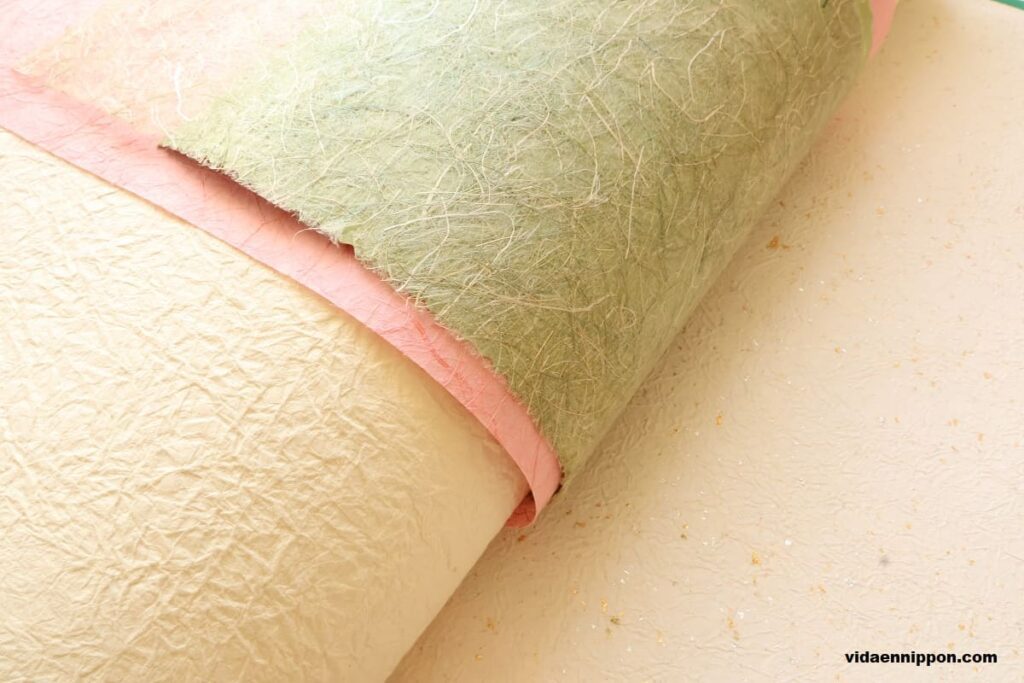Washi, traditional Japanese handmade paper, has a history of over 1,300 years. Known for its strength, durability, and beautiful texture, washi is widely used in calligraphy, woodblock prints, sliding screens, and various crafts. Its unique qualities have garnered admiration both in Japan and abroad. In this article, we’ll explore the key characteristics of washi, its raw materials, and the intricate process used to create this iconic paper.
Characteristics of Japanese Washi Paper
Below, I will explain the characteristics of Japanese Washi.
Unique Texture and Beauty of Washi
Washi is celebrated for its natural and delicate texture. The long fibers used in its creation give it a smooth yet distinct feel. Each sheet of handmade washi is unique, featuring variations in texture and pattern, making it a prized material for artistic creations and interior design.
Durability and Strength
Compared to Western paper, washi is incredibly strong. The long intertwined fibers of the plant materials used in washi give it exceptional durability. It’s resistant to tearing, even when wet, which is why it has been used for centuries in ancient documents, books, and restoration projects.
Absorbency and Breathability
One of the unique properties of washi is its high absorbency and breathability. It excels in regulating humidity, making it an ideal material for traditional Japanese sliding doors (shoji), lanterns, and wallpaper. Washi absorbs moisture in humid conditions and releases it in drier environments, acting as a natural humidifier.
Raw Materials of Washi
Kozo (Mulberry)
Kozo, or mulberry, is the primary material used in making washi. It is grown throughout Japan and is known for its long and durable fibers, which contribute to washi’s strength. Kozo fibers form the foundation of most types of washi.
Mitsumata
Mitsumata is another popular material used to make softer, more refined washi. It is known for producing smooth paper, making it an ideal choice for writing and printing. Mitsumata is also used in making Japanese banknotes due to its strength and texture.
Gampi
Gampi is considered the highest quality material for washi, producing paper with a glossy surface and a delicate finish. Gampi fibers are fine and provide a translucent quality to the paper, making it highly desirable for artistic and decorative applications.
How Washi is Made
Harvesting and Processing the Raw Materials
The process begins with harvesting the bark from plants such as kozo, mitsumata, or gampi. The bark is boiled to soften it and then manually pounded to separate the fibers. Impurities are carefully removed to ensure the final product is pure and clean.
The Traditional Papermaking Process
Once the fibers are prepared, they are mixed with water to create a slurry. The traditional papermaking technique involves using a bamboo or wooden screen to evenly spread the fibers. This step requires great skill to achieve a consistent thickness across the sheet. The sheet is then pressed to remove excess water.
Drying and Finishing
The sheets are carefully dried on wooden boards or glass surfaces to create a smooth texture. After drying, the paper is often polished to enhance its appearance and strength. This labor-intensive process is what gives washi its exceptional quality.
Q&A about Japanese Washi paper
- QHow is washi used?
- A
Washi is used in a variety of applications, including calligraphy, painting, lanterns, wallpaper, and even in everyday items like greeting cards and envelopes.
- QHow durable is washi paper?
- A
Washi is incredibly durable and can last for centuries when properly stored. Its strength is due to the long fibers used in its production, and it can resist tearing even when wet.
- QHow long does it take to make washi paper?
- A
The entire process, from harvesting raw materials to the final drying step, can take several days to weeks, depending on the scale of production and the specific type of washi being made.
You can buy Washi in Rakuten.
Rakuten has Global Express service.
Conclusion
Washi is a deeply rooted part of Japanese culture, admired for its beauty, durability, and versatility. Whether used for art, traditional crafts, or interior design, washi remains a beloved material, both in Japan and around the world. Its eco-friendly production methods and natural materials also make it a sustainable choice for many modern applications. For those seeking a connection to traditional craftsmanship, washi offers an unparalleled combination of function and artistry.

